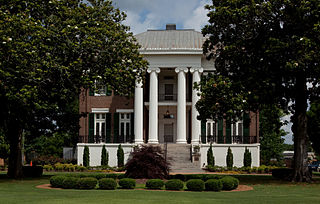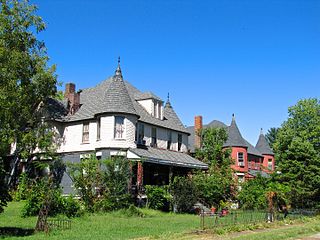
The Alabama Governor's Mansion is the official residence of the Governor of Alabama and the governor's family in Montgomery, the capital city of Alabama. The current Governor of Alabama, Kay Ivey lives at the governor's mansion. The original governor's mansion for Alabama was occupied from 1911 until 1950, when the current mansion was acquired. The current mansion was added to the National Register of Historic Places on July 3, 1972.

Rogers Hall, also known as Courtview, is a three-story antebellum house at 500 Court Street in Florence, Alabama. It was built from 1854 to 1855. It is one of the oldest historic landmarks on the University of North Alabama campus and one of the university's most distinctive structures. The building was recorded by the Historic American Buildings Survey from 1934–35. It was listed on the National Register of Historic Places on June 13, 1974.

The Old Dauphin Way Historic District is a historic district in the city of Mobile, Alabama, United States. It was named for Dauphin Way, now known as Dauphin Street, which bisects the center of the district from east to west. The district is roughly bounded by Broad Street on the east, Springhill Avenue on the north, Government Street on the south, and Houston Avenue on the west. Covering 766 acres (3.10 km2) and containing 1466 contributing buildings, Old Dauphin Way is the largest historic district in Mobile.

The Central Troy Historic District is an irregularly shaped, 96-acre (39 ha) area of downtown Troy, New York, United States. It has been described as "one of the most perfectly preserved 19th-century downtowns in the [country]" with nearly 700 properties in a variety of architectural styles from the early 19th to mid-20th centuries. These include most of Russell Sage College, one of two privately owned urban parks in New York, and two National Historic Landmarks. Visitors ranging from the Duke de la Rochefoucauld to Philip Johnson have praised aspects of it. Martin Scorsese used parts of downtown Troy as a stand-in for 19th-century Manhattan in The Age of Innocence.

There are nine historic districts in Meridian, Mississippi. Each of these districts is listed on the National Register of Historic Places. One district, Meridian Downtown Historic District, is a combination of two older districts, Meridian Urban Center Historic District and Union Station Historic District. Many architectural styles are present in the districts, most from the late 19th century and early 20th century, including Queen Anne, Colonial Revival, Italianate, Art Deco, Late Victorian, and Bungalow.

There are 69 properties listed on the National Register of Historic Places in Albany, New York, United States. Six are additionally designated as National Historic Landmarks (NHLs), the most of any city in the state after New York City. Another 14 are historic districts, for which 20 of the listings are also contributing properties. Two properties, both buildings, that had been listed in the past but have since been demolished have been delisted; one building that is also no longer extant remains listed.

The Orleans County Courthouse Historic District is one of two located in downtown Albion, New York, United States. Centered on Courthouse Square, it includes many significant buildings in the village, such as its post office and churches from seven different denominations, one of which is the tallest structure in the county. Many buildings are the work of local architect William V.N. Barlow, with contributions from Solon Spencer Beman and Andrew Jackson Warner. They run the range of architectural styles from the era in which the district developed, from Federal to Colonial Revival.

The Carlowville Historic District is a historic district in the community of Carlowville, Alabama. The historic district covers 780 acres (320 ha) and is centered on Alabama State Route 89 and Dallas County roads 4, 47 and 417. It was placed on the National Register of Historic Places on January 18, 1978.

The Laurel Hill Historic District is a predominantly residential historic district south of downtown Norwich, Connecticut. The district was added to the National Register of Historic Places on October 26, 1987. It extends south from the Shetucket River along Laurel Hill Avenue, River Avenue, and Spruce Street. This area was developed as a residential district beginning in 1850, and includes a significant number of well-preserved Italianate and Gothic Revival houses.

The Green Street Historic District is a historic district in Marion, Alabama. It is centered on West Green Street and includes examples of American Craftsman, Greek Revival, and Federal style architecture. It contains 33 structures, dating from the mid-1830s to the present, with 24 of them listed as contributing buildings. It was added to the National Register of Historic Places on May 30, 1979.

The Attalla Downtown Historic District is a historic district in Attalla, Alabama. The city was founded in 1870 along the Alabama and Chattanooga Railroad. It quickly developed into a major iron ore export hub. After fires in 1887 and 1891, most of the frame buildings downtown were replaced with brick structures. The oldest buildings in the district, which date from the 1880s and 1890s, are built in Folk Victorian styles, with corbelled cornices and other decorative elements. Later buildings are in more plain Commercial Brick styles, while others were built in more academic styles, including the Art Moderne Etowah Theatre and the Colonial Revival Post Office building. The district was listed on the Alabama Register of Landmarks and Heritage in 2011 and the National Register of Historic Places in 2013.

The Bridgeport Historic District is a historic district in Bridgeport, Alabama. Founded in the 1810s as a farming community, Bridgeport became a major transportation hub with the coming of the Nashville and Chattanooga Railroad and Southern Railway in the 1850s, in addition to its Tennessee River port. Due to the importance of its rail bridge, the town changed hands several times during the course of the Civil War. Industry began to move into the area in the late 1880s and 1890s, and commercial development of the downtown area soon followed. The district retains several one- and two-story commercial buildings, most constructed out of brick in simple styles popular in the late 19th and early 20th centuries. Many of the elite built their homes on Battery Hill, overlooking the river. The district contains several Victorian and Queen Anne houses, as well as Bungalows and Vernacular styles. The Mission Revival Nashville, Chattanooga, and St. Louis Railroad depot, three railroad bridges, and three Civil War fortifications are also contained in the district. The district was listed on the National Register of Historic Places in 2002.

The Florence Downtown Historic District is a historic district in Florence, Alabama. Florence was founded in 1818 by the Cypress Land Company, who counted among its trustees Creek War General John Coffee, future Governor of Alabama Thomas Bibb, early Huntsville settler LeRoy Pope, and future United States Senator and Supreme Court Justice John McKinley. The company hired Italian surveyor Ferdinand Sannoner, who divided the land into over 400 lots and named the town after Florence, Italy. The first Lauderdale County Courthouse was completed in 1822, and the oldest extant building in the district, the Gothic Revival First Presbyterian Church, was completed two years later. Most of the early buildings was destroyed by a fire in 1866. Development resumed in earnest in the 1880s as Florence's industrial economy developed with the addition of several cotton mills, and the Florence Wagon Works, among others. Other booms occurred in the 1920s with the construction of Wilson Dam, the establishment of the Tennessee Valley Authority in the 1930s, and during World War II as metals and chemical plants were drawn to the area.

The Locust Street Historic District is a historic district in Florence, Alabama. Situated to the northwest of downtown, the residential neighborhood began to develop during Florence's manufacturing-fueled economic boom of the late 1880s. Several large Victorian houses were built in the area around Thimbleton which was built before Tuscaloosa St.. was laid out in the design of Florence by Sannoner. In deference to Thimbleton, Tuscaloosa St. has less width than the other streets. Renowned historical architect, Harvey Jones described Thimbleton as having 3 well done restorations, the original structure being built between 1820–1825 with Federalist Architecture, facing Pine St..The last restoration was late 1800s with French Second Empire Period Architecture, adding 2 rooms, attaching the kitchen, and changing the mansion to face Tuscsloosa St. Other smaller Victorian cottages were also built, many by middle-class residents who moved to Florence looking for work or to take advantage of the city's schools.

The James Martin House is a historic residence in Florence, Alabama. Martin was a leading Florence industrialist of the Antebellum era, who owned a cotton spinning mill along Cypress Creek. He had come to Florence from Jefferson County, Kentucky, and established his mill in 1839. A fire destroyed the complex in 1844, but was rebuilt and reopened in 1850. The mill was destroyed during the Civil War, but not rebuilt before Martin's death in 1869. Martin's sons operated the mill until 1873, and owned the house until 1879. It was purchased in 1886 by John Bounds, and remained in his family until 1974.

The Seminary–O'Neal Historic District is a historic district in Florence, Alabama. The district runs along parts of North Seminary Street and East Irvine Avenue near the University of North Alabama campus. The 12 contributing properties are Vernacular cottages, bungalows, and Sears Roebuck-sourced American Foursquares. These were the styles most common in middle-class homes between 1908 and 1943, when Florence underwent a period of large growth driven by manufacturing and, later, the Tennessee Valley Authority. The two Foursquares, built in 1908 and 1926, sit next to each other on Seminary Street. The remaining structures on Seminary are bungalows. The three cottages, two of brick and one of wood, and one bungalow line Irving Avenue. The district was listed on the National Register of Historic Places in 1995.

The Walnut Street Historic District is a historic district in Florence, Alabama. Development of the neighborhood began in earnest in the 1890s, although the oldest house in the district dates from 1870. Florence's first economic boom after the Civil War began in the 1880s, and the newly minted upper-middle class began building homes to the east of older residential sections, such as Wood Avenue and the Sannoner District. The economy cooled in the 1900s and 1910s, only to pick up again in the 1920s with the construction of Wilson Dam and several textile mills.

The Wood Avenue Historic District is a historic district in Florence, Alabama. The residential neighborhood was primarily developed after Reconstruction, although five houses date from before the Civil War. By the time of Florence's economic boom of the 1880s, the most fashionable upper-class neighborhood in Florence, today known as the Sannoner Historic District, had already been filled in, leading development to move to Wood Avenue to the west. Most homes built during this time were large, Victorian structures, including many elaborate examples of Queen Anne architecture.

The Primrose Hill Historic District encompasses a group of high-quality 19th century residences in Belfast, Maine. Set on Church and High Streets between Primrose and Anderson, this area is where the elite of early 19th-century Belfast built their homes. Four of the five most prominent houses are Federal, while one is Gothic Revival in style. The district was listed on the National Register of Historic Places in 1973.























